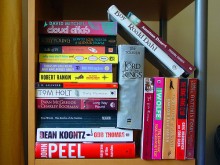Writing that relies heavily on any of the five senses (sight, sound, smell, taste and touch) for description is often called sensory writing.
Uses of Sensory Details and Imagery
Sensory writing is used in creative or descriptive writing to help the reader imagine the scene or object being described. It 'shows' the reader rather than 'telling' them, and makes the text more engaging and more interesting to read.
Examples of Sensory Writing
Instead of saying 'It was raining, but Tom still was excited,' a sensory description would use the senses to convey this, as shown in these examples:
Sight (visual): Is Tom restless or unable to keep still? Is the rain forming puddles?
Sound (auditory): What does Tom say that conveys his excitement? Is he laughing? Can the narrator hear the rain?
Smell (olfactory): Hopefully the narrator won't be able to smell Tom, but they might be able to smell the rain (wet grass, wet trees...)
Touch (tactile): Can the narrator feel the wind or rain on their face? Are they shivering?
Taste (gustatory): Does the narrator have a hot drink to keep them warm? What is it?
You don't have to use all five senses at once (this can seem forced or clunky, and stop the description from flowing smoothly), but using senses other than sight to describe something can really help the reader to imagine the scene.

